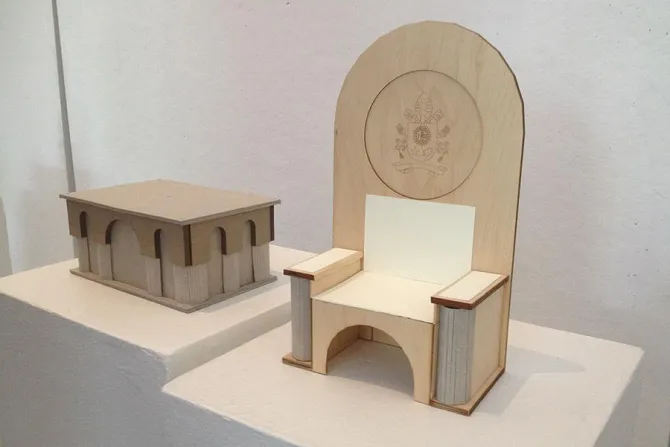Washington D.C., Jun 8, 2015 / 18:03 pm
For most graduating college seniors, the final weeks of school focus on exams, saying goodbyes and looking to their next steps in life.
But for three seniors studying architecture at The Catholic University of America, the final weeks of school presented the opportunity of a lifetime: the chance to design the altar and chair for Pope Francis' historic trip to Washington, D.C. this fall.
"I still don't really believe it's going to happen," said recent Catholic University graduate Ariadne Cerritelli. "We never thought that we would win," she told EWTN News Nightly.
Cerritelli and her teammates Matthew Hoffman and Joseph Taylor, also recent graduates of Catholic University, won a design contest that will put their creations at center stage for Pope Francis' first public Mass in the U.S.
An altar, ambo and chair made according to their design will be used at the outdoor papal Mass on Sept. 23 on the east steps of the Basilica of the National Shrine of the Immaculate Conception in Washington, D.C.
At the Mass, Pope Francis will canonize Blessed Junipero Serra, the first canonization ever to be conducted in the United States. The September visit will be the third time a Pope has visited the National Basilica and Catholic University. It will be the second time Catholic University students have designed furnishings for a papal Mass.
After the Mass, the pieces built for the trip will continue to be used as part of the permanent fixtures within the Great Upper Church of the Basilica of the National Shrine of the Immaculate Conception.
Cerritelli said that she and her teammates drew inspiration from the National Shrine – and from the humility of Pope Francis.
"The main inspiration was that we wanted everyone to be able to get a taste of the inside of the basilica, to get a taste of Pope Francis' mission," she said, citing the Pope's expressed desire not to stand out. It is her hope that their pieces will "blend in perfectly" with the surrounding architecture and will bring the motifs of the basilica to the outdoor Mass.
Others on the winning design team explained that they drew heavily from the basilica's Romanesque-Byzantine style, particularly the arches present throughout the building.
"One of the first thing we did was go inside the Shrine and get a feel for the space, look at what captured our eyes," Matthew Hoffman told EWTN News Nightly. "When we walked in there, our eyes were taken up with those arches, and that's the point, to take you up to God and up to heaven."
Yet the architecture of the church itself is very grounded – a feature Hoffman said the designers wanted to bring to their pieces.
"The actual part of the building that supports it is those arches, so it's planted in the ground, it's firmly rooted, and so we thought that was the perfect architectural language that we could use," he said.
Eighteen teams competed in the design competition, which was announced on April 28, with submissions due May 15 – a period which overlapped with some students' finals and end-of-year assignments.
The contest required students to build a scale model of at least one of the proposed pieces and to prepare a presentation of their design. They had to consider the style of the basilica in their proposal.
The competition was held by The Catholic University of America's School of Architecture and Planning, the Archdiocese of Washington and the Basilica of the National Shrine for the Immaculate Conception.
Its judges were Washington Archbishop Cardinal Donald Wuerl; Bishop Barry Knestout, auxiliary bishop of Washington; Catholic University president John Garvey; basilica rector Monsignor Walter Rossi; and Randall Ott, dean of the School of Architecture and Planning.
Bishop Knestout told CNA that the judges' decision considered the designs' simplicity and their ability to complement the existing Basilica space.
"There were a lot of beautiful designs," he said.
The bishop explained that the rounded arch of the National Shrine is a "very strong element" throughout the building. The winning design "expressed it in a very straightforward and simple way."
"Out of all the designs it was the only one that had the chair also repeat the same rounded arch," he added. The design "would look like it fits in the shrine itself."
The next steps, the bishop said, include the fabrication of the design and a decision on the materials to be used. This process will be worked out between the design team, the archdiocese and the National Shrine.
Hoffman said that when the big day comes, he may forget about his own creation.
"I may be honestly more distracted that I'm going to see the Pope, than that he is sitting in my chair," he said.



